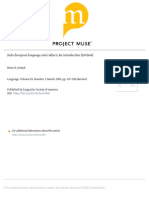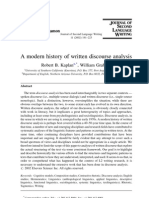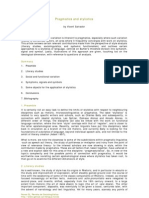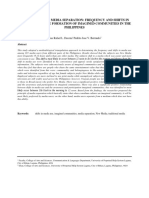0 ratings0% found this document useful (0 votes)
69 viewsWest African Pidgin-English: A Descriptive Linguistic Analysis With Texts and Glossary From Lhe Cameroon Area
West African Pidgin-English: A Descriptive Linguistic Analysis With Texts and Glossary From Lhe Cameroon Area
Uploaded by
Araceli EnríquezThis document summarizes a book about the Pidgin-English dialect spoken in Cameroon. It provides the following key details:
1) The book presents a descriptive linguistic analysis of the Pidgin-English spoken in Cameroon, including its phonology, morphology, syntax, and texts.
2) It takes a straightforward approach to presenting the material with many clear examples.
3) The analysis is based on classifying words as "functors" (grammatical markers) or "contentives" (lexical units) and their relationships.
4) While providing a valuable examination of the dialect, the summary criticizes the book for not adequately addressing code variation within the language.
Copyright:
© All Rights Reserved
Available Formats
Download as PDF, TXT or read online from Scribd
West African Pidgin-English: A Descriptive Linguistic Analysis With Texts and Glossary From Lhe Cameroon Area
West African Pidgin-English: A Descriptive Linguistic Analysis With Texts and Glossary From Lhe Cameroon Area
Uploaded by
Araceli Enríquez0 ratings0% found this document useful (0 votes)
69 views2 pagesThis document summarizes a book about the Pidgin-English dialect spoken in Cameroon. It provides the following key details:
1) The book presents a descriptive linguistic analysis of the Pidgin-English spoken in Cameroon, including its phonology, morphology, syntax, and texts.
2) It takes a straightforward approach to presenting the material with many clear examples.
3) The analysis is based on classifying words as "functors" (grammatical markers) or "contentives" (lexical units) and their relationships.
4) While providing a valuable examination of the dialect, the summary criticizes the book for not adequately addressing code variation within the language.
Original Description:
Edwards1972
Original Title
edwards1972
Copyright
© © All Rights Reserved
Available Formats
PDF, TXT or read online from Scribd
Share this document
Did you find this document useful?
Is this content inappropriate?
This document summarizes a book about the Pidgin-English dialect spoken in Cameroon. It provides the following key details:
1) The book presents a descriptive linguistic analysis of the Pidgin-English spoken in Cameroon, including its phonology, morphology, syntax, and texts.
2) It takes a straightforward approach to presenting the material with many clear examples.
3) The analysis is based on classifying words as "functors" (grammatical markers) or "contentives" (lexical units) and their relationships.
4) While providing a valuable examination of the dialect, the summary criticizes the book for not adequately addressing code variation within the language.
Copyright:
© All Rights Reserved
Available Formats
Download as PDF, TXT or read online from Scribd
Download as pdf or txt
0 ratings0% found this document useful (0 votes)
69 views2 pagesWest African Pidgin-English: A Descriptive Linguistic Analysis With Texts and Glossary From Lhe Cameroon Area
West African Pidgin-English: A Descriptive Linguistic Analysis With Texts and Glossary From Lhe Cameroon Area
Uploaded by
Araceli EnríquezThis document summarizes a book about the Pidgin-English dialect spoken in Cameroon. It provides the following key details:
1) The book presents a descriptive linguistic analysis of the Pidgin-English spoken in Cameroon, including its phonology, morphology, syntax, and texts.
2) It takes a straightforward approach to presenting the material with many clear examples.
3) The analysis is based on classifying words as "functors" (grammatical markers) or "contentives" (lexical units) and their relationships.
4) While providing a valuable examination of the dialect, the summary criticizes the book for not adequately addressing code variation within the language.
Copyright:
© All Rights Reserved
Available Formats
Download as PDF, TXT or read online from Scribd
Download as pdf or txt
You are on page 1of 2
108 A MERlCAN ANTHHOPOL,OGIST [ 74,19721
liiuqa nipliyqa ruwanqaml pleteness it provides an excellent intro-
‘if (when) I say, he’ll do it’ duction to this very important dialect of
(p. 50, 5.251) Qu ech u a.
ltumastin purikuEkankil
‘you’re walking around drinking’ West African Pidgin-English: A Descriptive
(p. 51, 5.253) Linguistic Analysis with Texts and
Glossary from lhe Cameroon Area.
Since there are other suffixes in Ayacucho G I L B E R T DONALD SCHNEIDER.
Quechua which may occur_with both verb Athens: Center for International Studies,
and substantive roots (-Za,-la, and the group Ohio University, 1966. xiii + 242 pp.,
of suffixes Parker labels “enclitics”) there tables, glossary, 9 appendices, biblio-
should be no objection to treating the graphies. $6.00 (paper). [ A thesis sub-
suffixes I-tiN/ and /-(NIn)tin/ as one. mitted t o the Hartford Seminary
Paralleling the discussion of substantive Foundation.]
and verb categories in chapters 4 and 5,
Parker discusses substantive and verb deriva- Reviewed 6y JAY D. EDWARDS
tion in chapters 6 and 7. Chapter 8 is a Louisiana State University
discussion of enclitics, chapter 9 of intona- This book is a reprint of the author’s
tion. Syntax is reserved for chapter 10, doctoral thesis, apparently unmodified. It
which comprises eight pages of the total presents a descriptive analysis of the Pidgin-
grammar. The brevity of this description English of the West Cameroon Highlands.
derives partly from the author’s purpose of Schneider is an American Baptist Missionary
being “strongly oriented towards morpho- who spent some thirteen years (1947-61) as
logy,” an orientation dictated by the highly missionary to the Mambila people. He has
agglutinative nature of the Quechua lan- published several previous works on
guage. When Parker deals with syntax, it is in Cameroon Pidgin-English including a teaoh-
a traditional structuralist way, disc ussing ing manual and a glossary.
endocentric and exocentric constructions, The book is divided into chapters
clauses and sentences. covering an introduction, phonology,
Parker’s Quechua dictionary covers 118 morphology, function classes, phrase analy-
or the 226 pages of the book. Perhaps sis, sentence analysis, a glossary, and Pidgin-
‘lexicon’ is a better way to describe it since English texts. Several appendices are
each entry has a minimal definition in included as well as a bibliography and an
English. Each entry gives the word in informant bibliography.
Quechua, then its form class, and a short One very pleasing aspect of this work is
English gloss. An asterisk procedes the entry the straightforward, logical manner in which
if it is a Spanish borrowing, and botanical the material is presented. Each point is made
terms are generally followed by their and immediately illustrated with several
scientific names. The one small problem is examples. Technical terms are almost always
the listing of alternative forms. For example clearly defined, and there is a pleasant
the form ruya is listed as (var. of yura) and deemphasis on linguistic jargon. Moreover,
one must flip back to yura t o find that IUYQ the author wisely avoids becoming entangled
means ‘plant (general)’. It would have been in theoretical arguments that might detract
quite easy for either the author or the from the descriptive purpose of the book.
editors to add the gloss for each entry, Because Schneider chooses not to employ
indicating, of course, which one was a the transformational method the book may
variant of the other so that the reader be appreciated by the interested non-linguist
would have been spared a certain amount of without much difficulty. The grammar of
frustration in using the dictionary. Pidgin-English is developed primarily on the
In conclusion, Parker’s grammar and basis of the relationships between “function
dictionary presents the most thorough classes.” Words are classified as either
analysis of Ayacucho Quechua to date. I t is “functors” (grammatical markers), or “con-
a useful reference work and, indeed, we tentives” (lexical units). The latter group
must agree with Hockett that it is a superior includes the open classes: noun, verb,
practical description. In its scope and com- adjective, and adverb, while the former
LINGUISTICS 109
subsumes determiners, pronouns, auxiliaries, exists a “common core” of broad (middle)
connectives, initiators, question words, and a Pidgin-English features shared throughout
class of “special forms,” several of which are the laboring class of West Africa, or at least
widely shared among Afro-English Creole West Cameroon. He feels it is this core which
languages (/meyk, sey, na, dey, bi, now/). permits mutual intelligibility between
Word classes are differentiated on the speakers of various ethnic and educational
basis of phonological, morphological, and backgrounds. In this assumption Schneider
syntactic criteria. A seemingly inordinate accepts the (outmoded) dogma of descrip-
emphasis is placed on the importance of tive linguistics, viz. that some ideal language
frequency counts. Perhaps the utility of this code may be discovered correctly describing
kind of information is not clear to me. “the speech” of a community or nation.
The method of data collection should be Socially oriented studies of speech have
noted. The corpus is drawn from published clearly demonstrated that this assumption
and other materials, some of which were tends to emphasize descriptive neatness at
transcribed by the author. Schneider is his the expense of ethnographic reality; that it
own principal informant. Since he first focuses attention away from the social lin-
arrived in the area at about the age of guistic processes shaping and upholding the
twenty-six it is not certain to what degree he codes they try to describe.
may be considered a “native” speaker. While Excepting this limitation, the reader is
he is certainly a “good” speaker of Pidgin- presented with a valuable examination of
English, the reader is left with some doubt Cameroon Pidgin-English-one that cannot
over the degree to which he may have drawn but increase our understanding of the
upon his own speech for the construction of relationships between the African-based
the rules of Pidgin-English. pidgin and creole languages.
This brings me to my primary reservation
regarding the book, which involves the
theoretical problern involved in representing The Languages of a Bilingual Community. J.
any language, and particularly a pidgin lan- R. RAY FIELD. Janua Linguarum. Studia
guage, with a statement aiming to describe a Memoriae Nicolai Van Wijk Dedicata.
single code or monolithic pattern. One of Series Practica, 77. The Hague & Paris:
the most salient features of the Afro-English Mouton, 1970. 118 pp., tables, 3 ap-
(and other) Creoles and Pidgins is the very pendices, bibliography, index. Dutch Gld.
great amount of code variation existing 28 (paper).
within and between speech communities. In
any such community in which social Reviewed b y JOAN RUBIN
mobility and travel are common, a profound Tulane University
emphasis is placed on the ability to mani- This volume is the result of a study done
pulate code varieties. If Cameroon Pidgin- sometime in 1958-59 of an elderly Yiddish
English is really to be considered a pidgin and English speaking community living along
language, what is the source of the nation- the beach area of Venice and Santa Monica,
wide social symbolic pressures that would California. Rayfield states the goal as the
result in speech code conformity? discussion of the processes and patterns of
Schneider recognizes the problem of code language change. Field methods used include
variation. He presents a chart (p. 10) to participant-observation, formal interviews, a
illustrate the scale of (phonetic?) variation “recollection” test, tape recordings of
from African-assimilated Pidgin, through “spontaneous” speech and Yiddish radio
broad Pidgin-English, to Anglicized Pidgin. programs.
He discusses the problem of language inter- There is something dissatisfying in read-
ference briefly (pp. 109-110), and he ing this book at a time when socio-linguistic
presents parallel texts illustrating the three methodology and analysis have received so
varieties (pp. 218-220, 225-229). He does much attention during this past decade. First
not analyze the two “non-standard” varieties of all, the data seem to have been collected
of Pidgin, nor does he discuss the problem of in a fairly haphazard manner. Although the
geographical variation in any detail. This is community reportedly consisted of twenty-
because his basic assumption is that there five hundred persons, only sixty participated
You might also like
- Benveniste Problems in General LinguisticsDocument267 pagesBenveniste Problems in General LinguisticsTolga Elbirlik100% (1)
- Technical Writing Essentials PDFDocument317 pagesTechnical Writing Essentials PDFGallet100% (2)
- Lyovin, Kessler, Leben. An Introduction To The Languages of The World PDFDocument545 pagesLyovin, Kessler, Leben. An Introduction To The Languages of The World PDFClaudio Chagas100% (7)
- Evidentiality The Linguistic Coding of Epistemology Advances in Discourse ProcessesDocument352 pagesEvidentiality The Linguistic Coding of Epistemology Advances in Discourse ProcessesLucia Popa100% (2)
- Berry, Margaret - An Introduction To Systemic Linguistics-ST. MARTIN's PRESS (1975)Document219 pagesBerry, Margaret - An Introduction To Systemic Linguistics-ST. MARTIN's PRESS (1975)Zayer Bebo100% (1)
- What Every Body Is Saying - An Ex-FBI Agent's Guide To Speed Reading People by Joe Navarro - NotesDocument8 pagesWhat Every Body Is Saying - An Ex-FBI Agent's Guide To Speed Reading People by Joe Navarro - NotesIoan Nicolae100% (2)
- Maugham's LanguageDocument25 pagesMaugham's LanguageYana LalayanNo ratings yet
- Basic Color Terms Their Universality and Evolution 1969Document3 pagesBasic Color Terms Their Universality and Evolution 1969Andrea Granados100% (1)
- Mary Key Male Female LanguageDocument3 pagesMary Key Male Female LanguageBronxyNo ratings yet
- Bickerton - Pidgin and Creole StudiesDocument26 pagesBickerton - Pidgin and Creole StudiesAna Isabel Marquez100% (2)
- Discovery of Language Linguistic Science in The Nineteenth CenturyDocument393 pagesDiscovery of Language Linguistic Science in The Nineteenth CenturyAntônio NetoNo ratings yet
- Philosophical Chairs HandoutDocument2 pagesPhilosophical Chairs Handoutapi-368515927No ratings yet
- Our Book's ReviewDocument2 pagesOur Book's ReviewYekie WookieNo ratings yet
- Ancient Indo-European Dialects: Proceedings of the Conference on Indo-European Linguistics Held at the University of California, Los Angeles April 25–27, 1963From EverandAncient Indo-European Dialects: Proceedings of the Conference on Indo-European Linguistics Held at the University of California, Los Angeles April 25–27, 1963No ratings yet
- Language_and_Dialect_Atlas_of_Kenya_VoluDocument2 pagesLanguage_and_Dialect_Atlas_of_Kenya_VoluNesri tubeNo ratings yet
- Languages of The West Indies Douglas TayDocument2 pagesLanguages of The West Indies Douglas TayGil GuardiaNo ratings yet
- The English Languages by Tom Mcarthur (Review)Document3 pagesThe English Languages by Tom Mcarthur (Review)shaileshmseNo ratings yet
- PHRASEOLOGY, LINGUISTICS AND DICTIONARY AndrewPawleyDocument13 pagesPHRASEOLOGY, LINGUISTICS AND DICTIONARY AndrewPawleyMaria TodorovaNo ratings yet
- Cowie Review 29.1Document11 pagesCowie Review 29.1alankuper49No ratings yet
- Catching Language - The Standing Challenge of Grammar Writing (Ameka, DenchDocument672 pagesCatching Language - The Standing Challenge of Grammar Writing (Ameka, DenchFrofScNo ratings yet
- Cognitive Linguistics and Non-Indo-European Languages PDFDocument464 pagesCognitive Linguistics and Non-Indo-European Languages PDFÁngel MolinaNo ratings yet
- F Nuessel M Resnick Introduccion A La HiDocument5 pagesF Nuessel M Resnick Introduccion A La Hi008090063No ratings yet
- Wiley American Anthropological AssociationDocument3 pagesWiley American Anthropological AssociationSimeon Pol'shinNo ratings yet
- Harriet Klein, Review of Amazonian Linguistics by Doris PayneDocument2 pagesHarriet Klein, Review of Amazonian Linguistics by Doris PayneMatthew ParhamNo ratings yet
- Ray CCC ReviewessayDocument17 pagesRay CCC Reviewessayapi-300477118No ratings yet
- Introductory Linguistics Robert A Hall JDocument3 pagesIntroductory Linguistics Robert A Hall JMd Abul Afzal MubashshirNo ratings yet
- A "Huge Book". Spoken and Written English: A Grammar For Advanced LearnersDocument19 pagesA "Huge Book". Spoken and Written English: A Grammar For Advanced LearnersKlau RRomeroNo ratings yet
- The Disciplinarity of Linguistics and Philology: November 2017Document24 pagesThe Disciplinarity of Linguistics and Philology: November 2017Racer abrahimNo ratings yet
- UFCLECTURES2023Document54 pagesUFCLECTURES2023rey naNo ratings yet
- (Eugene H. Casad, Gary B. Palmer, International Co (BookFi) PDFDocument464 pages(Eugene H. Casad, Gary B. Palmer, International Co (BookFi) PDFAdán Frías CastilloNo ratings yet
- Documentation of Languages With Revitalization in MindDocument11 pagesDocumentation of Languages With Revitalization in Mindtaryuman100% (1)
- American Association of Teachers of Spanish and Portuguese HispaniaDocument3 pagesAmerican Association of Teachers of Spanish and Portuguese HispaniaZairNo ratings yet
- Eloquence and Power the Rise of LanguageDocument7 pagesEloquence and Power the Rise of LanguageStefan GuntherNo ratings yet
- LNG 1100Document7 pagesLNG 1100SylenetteNo ratings yet
- Discourse Analysis and Literary Theory - Closing The Gap ROBERT DE BEAUGRANDEDocument26 pagesDiscourse Analysis and Literary Theory - Closing The Gap ROBERT DE BEAUGRANDET-k SanaaNo ratings yet
- Geoffrey N Leech - A Linguistic Guide To English Poetry (Cut) (1969-2013) )Document26 pagesGeoffrey N Leech - A Linguistic Guide To English Poetry (Cut) (1969-2013) )Almas ZulfanidaNo ratings yet
- Statement PreviewpdfDocument24 pagesStatement Previewpdfpurbahaholongan02No ratings yet
- Diachronic Studies in Romance LinguisticsDocument256 pagesDiachronic Studies in Romance LinguisticsAle XanderNo ratings yet
- An Introduction To African LanguagesDocument14 pagesAn Introduction To African LanguagesDaniel SouzaNo ratings yet
- The Cardinal Differences Between Traditional Grammarand Structural GrammarDocument16 pagesThe Cardinal Differences Between Traditional Grammarand Structural Grammarvictoriaeva95No ratings yet
- Yakov Malkiel - Dubious Names of Languages (Costano-An, Occitan-Ian) Romance Philology Volume 25 Issue 4 1972Document2 pagesYakov Malkiel - Dubious Names of Languages (Costano-An, Occitan-Ian) Romance Philology Volume 25 Issue 4 1972陳正聲No ratings yet
- Francis P. DinneenDocument464 pagesFrancis P. DinneenFatima Mirza100% (2)
- A Colonial Grammar or ArteDocument16 pagesA Colonial Grammar or ArteDannielCarvalhoNo ratings yet
- Nilsen 1974Document3 pagesNilsen 1974R.A AlfiaturNo ratings yet
- Indo European Language and CultureDocument5 pagesIndo European Language and CultureprasanyawNo ratings yet
- A Modern History of Written Discourse Analysis - 2002Document33 pagesA Modern History of Written Discourse Analysis - 2002Shane Hsu100% (1)
- The Philosophic Grammar of American Languages, as Set Forth by Wilhelm von Humboldt: With the Translation of an Unpublished Memoir by Him on the American VerbFrom EverandThe Philosophic Grammar of American Languages, as Set Forth by Wilhelm von Humboldt: With the Translation of an Unpublished Memoir by Him on the American VerbNo ratings yet
- Pidgin Creole StudiesDocument26 pagesPidgin Creole Studiesanas.serrari-etuNo ratings yet
- Czerwionka 2015Document2 pagesCzerwionka 2015Panty StockingNo ratings yet
- The Handbook of Phonological Theory PDFDocument791 pagesThe Handbook of Phonological Theory PDFThekra Altweejry86% (7)
- SDIndex JVMDocument443 pagesSDIndex JVMPaulo VictorNo ratings yet
- Heine GrammaticalizationDocument401 pagesHeine GrammaticalizationNick MarkNo ratings yet
- Proto-languageDocument4 pagesProto-languageFaisal AbdoNo ratings yet
- UCHUMATAQU ReseñaDocument4 pagesUCHUMATAQU Reseñasergio2385No ratings yet
- Harrison Rev by Nevins SingermanDocument6 pagesHarrison Rev by Nevins SingermanJamna SinghNo ratings yet
- The Disciplinarity of Linguistics and Philology: November 2017Document24 pagesThe Disciplinarity of Linguistics and Philology: November 2017Nicholas DominicNo ratings yet
- RRL 2 2011 06-Comptes ReviewsDocument10 pagesRRL 2 2011 06-Comptes ReviewsKennethCabañasNo ratings yet
- Descriptive Linguistics: January 2013Document5 pagesDescriptive Linguistics: January 2013Rosna Sari MauludinaNo ratings yet
- Languages History and VarietiesDocument67 pagesLanguages History and VarietiesFrancois ReinkeNo ratings yet
- Review of Norman Jerry 2013 A ComprehensDocument6 pagesReview of Norman Jerry 2013 A ComprehensCheeseburger The GreatNo ratings yet
- PRESTON 1989 Perceptual DialectologyDocument33 pagesPRESTON 1989 Perceptual DialectologyAmanda Timmen MelloNo ratings yet
- Linguistics For Non Linguists A Primer With Exercises 2nd Ed Frank Parker and Kathryn Riley Boston Ma Allyn and Bacon 1994 PP V 337Document2 pagesLinguistics For Non Linguists A Primer With Exercises 2nd Ed Frank Parker and Kathryn Riley Boston Ma Allyn and Bacon 1994 PP V 337Thakur Anjeev PrakashNo ratings yet
- Prepositions in American and British English: AbstractDocument10 pagesPrepositions in American and British English: AbstractAraceli EnríquezNo ratings yet
- Infancia y Aprendizaje: Journal For The Study of Education and DevelopmentDocument18 pagesInfancia y Aprendizaje: Journal For The Study of Education and DevelopmentAraceli EnríquezNo ratings yet
- Dieter Stern: остроги, alsoDocument30 pagesDieter Stern: остроги, alsoAraceli EnríquezNo ratings yet
- Reviews: Homas ErrickDocument10 pagesReviews: Homas ErrickAraceli EnríquezNo ratings yet
- Empowering Nigerian Pidgin: A Challenge For Status Planning?Document15 pagesEmpowering Nigerian Pidgin: A Challenge For Status Planning?Araceli EnríquezNo ratings yet
- A Comparison of The Varieties of West African Pidgin EnglishDocument19 pagesA Comparison of The Varieties of West African Pidgin EnglishAraceli EnríquezNo ratings yet
- The Dutch Vascular Factors in Dementia Study: Rationale and DesignDocument8 pagesThe Dutch Vascular Factors in Dementia Study: Rationale and DesignAraceli EnríquezNo ratings yet
- 238 Letters and Correspondence: Hepatitis Virus Infection in Waldenstrom's MacroglobulinemiaDocument2 pages238 Letters and Correspondence: Hepatitis Virus Infection in Waldenstrom's MacroglobulinemiaAraceli EnríquezNo ratings yet
- Late Reversibility of Chronic Ifosfamide-Associated Nephrotoxicity in A ChildDocument3 pagesLate Reversibility of Chronic Ifosfamide-Associated Nephrotoxicity in A ChildAraceli EnríquezNo ratings yet
- Ohshima1996 PDFDocument8 pagesOhshima1996 PDFAraceli EnríquezNo ratings yet
- IL-6 By: Characteristics of and TNF-a Production Respiratory Syncytial Virus-Infected Macrophages in The NeonateDocument5 pagesIL-6 By: Characteristics of and TNF-a Production Respiratory Syncytial Virus-Infected Macrophages in The NeonateAraceli EnríquezNo ratings yet
- Pontisso1996 PDFDocument4 pagesPontisso1996 PDFAraceli EnríquezNo ratings yet
- Canteros 2005Document6 pagesCanteros 2005Araceli EnríquezNo ratings yet
- Neel1999 PDFDocument5 pagesNeel1999 PDFAraceli EnríquezNo ratings yet
- Makcos1994 PDFDocument4 pagesMakcos1994 PDFAraceli EnríquezNo ratings yet
- Inhibition of Marrow CFU-E Colony Formation From Human Immunodeficiency Virus-Infected Patients by and Y-InterferonDocument3 pagesInhibition of Marrow CFU-E Colony Formation From Human Immunodeficiency Virus-Infected Patients by and Y-InterferonAraceli EnríquezNo ratings yet
- Hepatitis C Virus in Non-Hodgkin's Lymphoma. A Reappraisal After A Prospective Case-Control Study of 300 PatientsDocument6 pagesHepatitis C Virus in Non-Hodgkin's Lymphoma. A Reappraisal After A Prospective Case-Control Study of 300 PatientsAraceli EnríquezNo ratings yet
- Direct View On Nanoionic Proton Mobility: WWW - Afm-Journal - deDocument11 pagesDirect View On Nanoionic Proton Mobility: WWW - Afm-Journal - deAraceli EnríquezNo ratings yet
- Czechoslovak Fine Chemicals Standars Vol 2 M Nedeljak Editor Che 1958Document1 pageCzechoslovak Fine Chemicals Standars Vol 2 M Nedeljak Editor Che 1958Araceli EnríquezNo ratings yet
- Processing Models For Children's Story ComprehensionDocument21 pagesProcessing Models For Children's Story ComprehensionAraceli EnríquezNo ratings yet
- Chapter 3. Types of EquivalentsDocument6 pagesChapter 3. Types of EquivalentsKazbek KuandykovNo ratings yet
- Inglés 3 - Examen y Criterios de CorrecciónDocument2 pagesInglés 3 - Examen y Criterios de CorrecciónjoseplinNo ratings yet
- Unpacking of English 5 1 Quarter: San Vicente Elementary SchoolDocument3 pagesUnpacking of English 5 1 Quarter: San Vicente Elementary SchoolTeresa Medina TicsayNo ratings yet
- Chapter 1, Communication Skills-II NotesDocument1 pageChapter 1, Communication Skills-II NotesTitan Angry boyNo ratings yet
- 1 PBDocument9 pages1 PBTaksh PathakNo ratings yet
- WAIS-IV Profile of Cognition in SchizophreniaDocument12 pagesWAIS-IV Profile of Cognition in SchizophreniaTheo KhouryNo ratings yet
- Languages in Scotland - What's The Problem?Document45 pagesLanguages in Scotland - What's The Problem?The Royal Society of EdinburghNo ratings yet
- MGT 500 Week 4Document5 pagesMGT 500 Week 4Victor MuchokiNo ratings yet
- ЕНГЛЕСКИ ЈЕЗИК РАЗРЕД: 2. разред гимназије УЏБЕНИК: Solutions 2nd edition Intermediate (Oxford University Press / Нови Логос)Document4 pagesЕНГЛЕСКИ ЈЕЗИК РАЗРЕД: 2. разред гимназије УЏБЕНИК: Solutions 2nd edition Intermediate (Oxford University Press / Нови Логос)mirkazoranacaNo ratings yet
- Pragmatics and StylisticsDocument7 pagesPragmatics and StylisticsAri A. ResulNo ratings yet
- Teaching Project Summary Paper Nur 402Document19 pagesTeaching Project Summary Paper Nur 402api-369824515No ratings yet
- Supervisor Workplace Skills Series: DelegationDocument14 pagesSupervisor Workplace Skills Series: Delegationrossaniza RamlanNo ratings yet
- High School Student Self Assessment - Landscape PDFDocument7 pagesHigh School Student Self Assessment - Landscape PDFToni ErdfeldNo ratings yet
- Strategies For The Written Expression QuestionsDocument6 pagesStrategies For The Written Expression QuestionsAbdul Rapiq PaneNo ratings yet
- Decena Decena Bermudo ImradDocument20 pagesDecena Decena Bermudo ImradEli DecenaNo ratings yet
- Understanding Indian CultureDocument16 pagesUnderstanding Indian CultureRavi Soni100% (1)
- Geriatric Depression Scale (Short Form) : Joanna Padiaon MAY 10, 2020Document2 pagesGeriatric Depression Scale (Short Form) : Joanna Padiaon MAY 10, 2020Jess RitumaltaNo ratings yet
- Write-Rite: Enhancing Handwriting Proficiency of Children With Dysgraphia Norsafinar Rahim & Zulikha JamaludinDocument19 pagesWrite-Rite: Enhancing Handwriting Proficiency of Children With Dysgraphia Norsafinar Rahim & Zulikha JamaludinMarilyn BucahchanNo ratings yet
- Past Simple Passive Form Reported Speech Imperatives Should and Must (For Obligations)Document31 pagesPast Simple Passive Form Reported Speech Imperatives Should and Must (For Obligations)SyaZana ShahromNo ratings yet
- (Perspectives in Cognitive Neuroscience) Benjamin Libet - Mind Time - The Temporal Factor in Consciousness (2005, Harvard University Press)Document271 pages(Perspectives in Cognitive Neuroscience) Benjamin Libet - Mind Time - The Temporal Factor in Consciousness (2005, Harvard University Press)Rodrigo Sanz40% (5)
- Professor Lucia Miree American University in BulgariaDocument75 pagesProfessor Lucia Miree American University in BulgariaShampa ChakrabertyNo ratings yet
- LP of Function Composition (DASVI)Document6 pagesLP of Function Composition (DASVI)Vince OjedaNo ratings yet
- What Makes A Family Strong and Successful?Document1 pageWhat Makes A Family Strong and Successful?Chinmayee SrivathsaNo ratings yet
- Training Needs AnalysisDocument2 pagesTraining Needs AnalysisVanessa G. ManguilimotanNo ratings yet
- R. 1 Social Media ExposureDocument47 pagesR. 1 Social Media ExposureRoxanne EnriquezNo ratings yet
- The Article AdvancedDocument3 pagesThe Article AdvancedAlexandruOpreanNo ratings yet













































































































